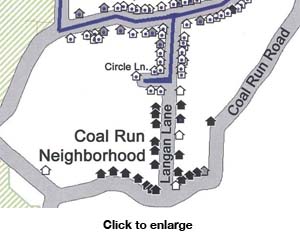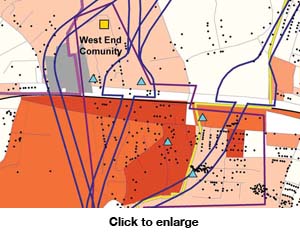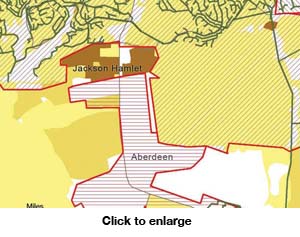To get to the headquarters of the Cedar Grove Institute for Sustainable Communities, visitors have to navigate a lengthy dirt road past white picket fences, grazing horses and a variety of outbuildings in various stages of disrepair. Set in a one-room former Primitive Baptist church on a 43-acre spread in rural Orange County, N.C., the institute holds a collection of old, ergonomically incorrect wooden desks and metal filing cabinets. The only signs of modernity are computers atop the desks.
Institute founders Allan Parnell and Ann Joyner, who live in a modest country house a stone’s throw from this office, are dressed in their everyday summer attire, T-shirts and shorts. But when they begin pulling maps off printers, Parnell and Joyner step decidedly out of the last century. “Our daughter tells people we work for the CIA, because what we do is so hard to describe,” Parnell says, only half-joking.

Joyner displays a series of maps showing the Coal Run neighborhood, a handful of streets located just outside the city limits of Zanesville in central Ohio. The first map provides a simple baseline, showing the city water plant and the boundary between the city and Coal Run, a part of Muskingum County. The second map adds water lines, which serve only the northern half of Coal Run. Successive maps add the residences in Coal Run, note which residences have water and which don’t, and break down their occupancy by race.
The last map puts all the data together, and the picture suddenly comes into sharp focus: Almost all the white households in Coal Run have water service, while all but a few black homes do not.
The institute’s maps played a vital role in a federal jury’s decision last year to award the excluded Coal Run residents almost $11 million in damages from the city of Zanesville and Muskingum County. The supporting evidence was strong on its own: African-American residents without water had made repeated requests over a period of almost 50 years to remedy the inequity, to no avail. Instead, they had to haul water from the plant or pump it from wells contaminated with sulphur and oil from old mining operations. In the interim, Zanesville had extended its water lines on numerous occasions to new, predominantly white developments that were farther away from the water plant than Coal Run.

But the maps provided something that the narrative and statistics lacked, says civil rights attorney Reed Colfax, who represented the Coal Run residents. “We could articulate the case in words,” Colfax says. “But when you’d put up the maps, they’d stop listening to you and look at them [as if to] say, ‘Is this really possible?'”
The Cedar Grove Institute has been using maps to exhibit patterns of municipal discrimination against low-income and minority communities for almost a decade. The patterns, rooted in the days when residential discrimination was supported by law, have been reinforced under the cover of such contemporary land-use mechanisms as annexation, zoning and extra-territorial controls.
To produce the maps, the institute employs geographic information systems technology, a computer-based tool for organizing, analyzing and displaying data in a spatial or geographic context. While the maps seem simple, producing them is anything but. Data must be collected from a host of sources, including government databases, door-to-door surveys and Global Positioning System devices. The data is digitized, analyzed, converted to images and layered together in various combinations.
Once the exclusive province of government, industry and academia, GIS technology has evolved rapidly since the 1980s, paralleling exponential gains in computer power and capacity. Affordable, user-friendly GIS software, online-mapping systems and the explosion of government data available on the Web have combined to speed the spread of GIS into the public arena.
This democratization of GIS has spurred new thinking about its potential application at the grassroots, rather than institutional, level. University of North Carolina School of Law Dean Jack Boger has worked with the institute on some of its municipal discrimination cases and concluded that the phenomenon of exclusion knows few geographic boundaries. “This is a problem of nationwide scope,” Boger says. “The evidence is, in effect, irrefutable.”
The exclusion of poor and minority communities from municipal services is but one social ill that GIS mapping can illustrate and help alleviate. Today, an increasing number of academics, attorneys, nonprofits and community groups are using maps to identify social problems, devise solutions and leverage change. GIS is being deployed to combat discrimination and inequities in education, health care access, housing, employment opportunities, transportation and law enforcement. “You’re not up to date in social justice advocacy if you don’t know how to use GIS maps,” says Anita Earls, director of the Southern Coalition for Social Justice in Durham, N.C.
Still, GIS is in its relative infancy as a popular science, and public awareness of its attributes and capacity is relatively low. Although most people have been exposed on the Internet to such GIS-based products as Google Maps, few can identify the technology behind them. Sarah Elwood, a geography professor at the University of Washington who has spread the GIS gospel to community groups, often encounters a baseline ignorance of the concept. “You say ‘GIS’ and people say, ‘Oh, yeah, I have one of those in my car,'” Elwood says.
The dots on the GIS-awareness map may be sparse, but those who have experienced the transformative power of GIS mapping have no doubt that the technology will eventually become firmly entrenched in the public consciousness. “People are jaded with statistics, and even more jaded with pie charts and graphs,” says Keith Ernst, research director at the Center for Responsible Lending in Durham, which has used maps to identify patterns of predatory lending in low-income communities. “But if you put the information on a map, people are more willing to hear what you say. We’re visual creatures, and seeing is believing.”
Allan Parnell recalls the day he first grasped the sweeping potential of GIS-based advocacy. Parnell was giving a talk at the University of North Carolina law school about the institute’s first municipal discrimination case, which involved his hometown of Mebane, N.C. As in Zanesville, residents of largely minority neighborhoods outside Mebane’s boundaries lacked water, sewer and other basic town services, despite decades of requests for relief.
Meanwhile, the town had annexed and provided services over the years to a hodgepodge of overwhelmingly white, affluent satellite developments that were farther away from the town center than the minority neighborhoods. This pattern of annexation and exclusion, dubbed “municipal underbounding” by University of Tennessee geography professor Charles Aiken, created virtual islands of poverty and neglect within the town.
After the presentation, a group of black students approached Parnell with similar stories of their own. “They told me, ‘This is happening in my grandmother’s town,'” he says. “That was the light-bulb moment: This isn’t just one case; it’s a pattern.”
A geographer by training with advanced degrees in sociology and demographics, Parnell had used GIS in health-related studies for the National Academy of Sciences and other agencies beginning in the late 1980s. He and his wife, Ann Joyner, formed a company in 1999 that specialized in GIS-based health research. But Parnell, a self-described “conflict-avoiding academic,” had had little opportunity or inclination to agitate on behalf of the disadvantaged.
One day in 2001, Parnell took a call from a community organizer in Mebane who was trying to stave off a highway bypass that would run through the heart of his neighborhood. Would Parnell assist him with a grant application? He met with the organizer, who detailed Mebane’s methods of using town boundaries to disenfranchise the neighborhood while controlling its destiny through the use of extra-territorial jurisdiction, an area adjacent to city limits over which municipalities can exert some influence. “I just sat there with my jaw on the floor for three hours,” Parnell says.

Parnell and Joyner agreed to create a visual and statistical profile of the town using standard GIS methodology. The first task was to gather the mountain of data that would be relevant. A former journalist and real estate developer, Joyner knew where to find comprehensive land-use and infrastructure information. Mebane’s public works department provided the locations of water and sewer lines. From the planning department they obtained historical annexation documents. Federal census data broke out racial and economic variables at the block level. They reviewed city council meeting minutes for evidence of action and inaction on service and annexation requests.
Using stock GIS software, Parnell and Joyner digitized the mass of data in compatible formats — a major undertaking in itself — and analyzed it. To produce the maps, they enlisted Bucknell University GIS expert Ben Marsh, a former graduate school classmate of Parnell’s. The three published a case study of Mebane in 2003 and shared it with Jack Boger, then-deputy director at the UNC Center for Civil Rights. “What was immediately apparent was how clear the relationship was between the exclusion of services and the racial makeup of the community,” Boger says.
Inspired by the Mebane study and law school experience, Parnell and Joyner formed the nonprofit Cedar Grove Institute for Sustainable Communities and in 2004 won a foundation grant to map communities throughout North Carolina. They found patterns of exclusion similar to those identified in Mebane across the state.
The institute’s maps of Moore County, home to some of the nation’s most prestigious and affluent golfing communities, were among their most dramatic examples of underbounding. The maps show the boundaries of three county municipalities, Pinehurst, Southern Pines and Aberdeen, a tortured maze of red lines that zigzag in all directions, creating angular amoebas.
A batch of dark brown blotches stand prominently outside the limits of all three towns, though they are hemmed in or virtually surrounded by the three towns. The blotches represent communities with overwhelmingly African-American populations and names — Lost City, Monroe Town and Jackson Hamlet — that evoke images of the Jim Crow era.
The maps also show the distribution of sewer lines in the county, which either stop at town borders or go through them but provide no hookups beyond, so the communities outside the town limits have no sewer service. Annexations over the years have swallowed acreage all around the three towns but carefully avoided the minority neighborhoods.
Parnell and Joyner add a sobering narrative to the maps that magnifies the extent of the exclusion of the communities outside town limits: Septic systems have routinely failed, spilling raw sewage next to homes. Residents lack the garbage service enjoyed by people who live in town and must instead pay for a costly private hauler or burn their trash at home. In the Midway community, neighbors watch garbage trucks cut through their main street to serve the citizens of Aberdeen, who live to either side. Police protection is provided by the county sheriff’s department, which must travel as much as 15 miles to respond to emergencies — even though municipal police stations are much closer, in some cases just blocks away.
The maps became an integral part of a successful campaign to eliminate the most odious aspects of exclusion in Moore County, and not just in terms of educating decision-makers. For the community groups involved in the campaign, the maps offered a kind of external validation that their narrative alone could not provide. “For me, they were a verification of what I’ve always known,” says Maurice Holland, president of the Midway Community Association and a lifelong resident of the neighborhood.
Since then, the institute has extended its reach beyond state lines. Presentations at conferences and workshops have connected the institute with attorneys working on municipal discrimination cases in California, Virginia, New York, Florida and Texas. While some of the cases center on underbounding, others address additional ways by which municipalities discriminate. In the Florida case, Guatemalan residents in the city of Lake Worth demonstrated that selective code enforcement resulted in the targeting of Latinos for eviction. An analysis of redevelopment efforts in Portsmouth, Va., showed that white residents and developers were the primary beneficiaries of the city’s largesse, while black communities were systematically wiped from the landscape to make way for land uses that generated more tax revenue.

And in Dallas, African-American and Latino residents in the inaptly named community of Cadillac Heights sued the city for using zoning regulations to segregate them in an industrial sector — a pattern that traced back to the 1940s, before the influx of Latinos to the city, when land records denoted minority residential areas with the letter “N.” Living next to industrial facilities had predictable consequences for residents: chronic health problems, a dearth of public services and permanently depressed property values.
In each instance, GIS maps have proven instrumental in either making the case that discrimination had occurred or influencing the outcome of a government decision about the discrimination. The city of Dallas, for example, settled with the residents and agreed to relocate them to more hospitable environs. Attorney Mike Daniel, who represented the plaintiffs, credits the maps with tipping the balance. This was the second suit brought by residents for the same cause, he notes, but the first one had ended with a nominal settlement that did not remedy the problem. “The history of the two cases was the same,” Daniel says. “The only difference was Cedar Grove’s work.”
Most of the Cedar Grove Institute’s recent GIS work has been for attorneys in support of municipal discrimination lawsuits, but the law offers few remedies in such cases. Provisions in the federal Civil Rights, Fair Housing and Voting Rights acts prohibit discrimination based on race and other factors, but local circumstances don’t often fit neatly into one of those provisions, and proving that the law was violated is no simple endeavor. Moreover, to win in court, plaintiffs must prove that the discrimination was intentional.
Only a handful of states offer similar protections against discrimination. Further constricting the playing field is a counterintuitive reality: Local government practices that result in exclusion and inequity are, for the most part, legal. Annexation laws, for example, usually permit municipalities to make annexation decisions based on economic considerations. If an annexation provides a net economic benefit, the city can move forward; if the costs of providing services to the annexed territory exceed new tax revenues, the city is free to say no.
And the time and expense of a legal case — often measured in years and millions — are prohibitive for the communities most likely to be the object of discrimination.
Because of these hurdles, some advocacy groups with a GIS focus deploy their maps in the service of less adversarial strategies. The Kirwan Institute at Ohio State University engages in “opportunity mapping,” which begins with the assumption that opportunities for high-quality housing, employment, education, health care and other key indicators should be distributed equally throughout a given metropolitan area. Kirwan maps identify disparities in the distribution of opportunities, which in turn provides direction for policymakers to correct those disparities.
In a similar vein, the Los Angeles-based Advancement Project takes a solution-oriented approach with its mapping initiative, the Healthy City Project. An interactive, online compendium of demographic, economic and health data for Los Angeles County, Healthy City also pinpoints the location of services for referral purposes and lets users create maps to identify concerns in their own neighborhoods. Developed in collaboration with an innovative GIS lab at UCLA, the Healthy City platform is so advanced that stakeholders often consult with project staff to inform policy debates and decisions.
Healthy City was hired by the city to produce maps in conjunction with an initiative to shift the approach to gang violence from enforcement and suppression to prevention. Healthy City produced maps that showed gang hot spots as well as services available to young people; the maps helped the city target areas where services were in shortest supply for additional investment. “We don’t only want to show problems,” says John Kim, who has directed Healthy City since its inception in 2002. “We want to show ways to solve those problems.”
Historians cite ancient cave paintings of migratory game routes as a primitive geographic information system, the superimposition of data on a geographic image. An English physician mapped the location of London residents sickened by cholera during an outbreak in 1857, which he analyzed to identify the source of the disease. Advancements in photographic processes in the early 20th century enabled the creation of translucent images of geographically ordered demographic data that could be layered atop a map, a technique pioneered by the Roosevelt administration during the Depression.
Though these antecedents arguably combine geography and information into a kind of system, GIS is most commonly associated with sophisticated computer hardware and software, its origins dating back to the days of mainframes and punch cards. In 1962, the Canadian government unveiled the Canada Geographic Information System, a prototype that mapped select land-use variables throughout the country for planning purposes.
Private vendors began to sell off-the-shelf GIS software in the 1980s; a decade later, further refinements in those packages combined with a steady drop in hardware prices made GIS available to anyone with sufficient technical background and skill. The runway was clear for takeoff.
Commercial users were among the first to take advantage. Market researchers mapped demographic data on household income, population density and the location of competitors to choose optimal sites for retail expansion. Engineering firms mapped roads and infrastructure to streamline their projects.
Federal, state and local government agencies also found GIS an invaluable way to increase efficiencies. The time spent on planning, permitting and conducting environmental or health assessments could be cut to a sliver with accurate databases and maps. Law enforcement agencies mapped crime incidence; few government operations, in fact, did not benefit from a GIS application. One of the largest single repositories of government data, the U.S. Census, has likely launched more GIS maps than any other single data source.
Much of that government data has now been posted to the Web. For advocates using GIS, the flood of data has been a boon. Parnell says the Cedar Grove Institute would never have emerged from the conceptual phase without the ability to obtain government data. “We realized that there’s a critical mass of data out there,” he says. “Five years earlier, we couldn’t have done it.”
Not all local governments appreciate the rise of GIS-driven advocacy, especially when their own data is used as a hammer against them, and they have begun to restrict public access. Some have pulled data off the Web in the alleged interest of national security; others charge exorbitant fees to produce it or deliver jumbled masses of data that are difficult to manage or decipher.
Mebane, the Cedar Grove Institute’s first case study of municipal discrimination, passed an Infrastructure Information Security Policy shortly after the study was published; the policy limited infrastructure data access to qualified engineering firms and town agencies. The city of Modesto, Calif., locked in a legal underbounding battle, pulled its infrastructure data off the Internet after the lawsuit was filed, citing national security grounds. “There’s no conceivable national security interest in where the traffic lights are in Modesto,” scoffs Ben Marsh, the institute’s chief mapmaker. A recent appellate ruling in California rejected a similar national-security rationale, as well as a copyright argument by Santa Clara County, but whether that opinion stands as precedent remains to be seen.
Though restrictions on access to government data could prove troublesome, advocacy groups that use GIS have already been finding data sources outside of government. In particular, data collected by community residents have become an effective supplement to the “official story,” as University of Washington professor Sarah Elwood calls government data.
Elwood has used GIS not only to map problems but to build the capacity of underserved and disadvantaged communities to advocate on their own behalf. Simple walking surveys that catalogue infrastructural deficiencies — potholes in sidewalks, missing stop signs, burned-out streetlights — fill gaps in the public record that mask actual conditions on the ground. With locally produced data, Elwood says, “You can tell a very detailed and very current, compelling story about neighborhood needs.”
One of the few brakes slowing the GIS freight train, at least from an advocacy perspective, is the shortage of people who understand it well. “Obviously, there is a much greater demand for GIS than there are practitioners,” says attorney Eric Schultheis, who coordinates The Race Equity Project for Legal Services of Northern California and counts himself among the GIS crowd. “You could probably count the number of people who are actually doing this work on both hands.”
But given the leaps that GIS technology and applications have taken in the political and legal advocacy sectors, it’s hard to imagine the GIS trend reversing. By January of next year, Healthy City plans to cover the entire state of California, and Kim says he’s received expansion requests from other cities. Healthy City uses free, open-source GIS software that can be customized as needed. The ready supply of cheap hardware and software can only hasten the arrival of the day when GIS mapping is as universal as photo or music editing.
“The technology will soon become ubiquitous,” Kim says simply.
Sign up for our free e-newsletter.
Are you on Facebook? Become our fan.
Follow us on Twitter.




